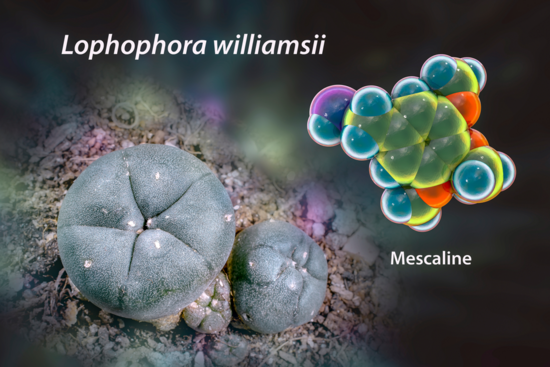Summary
Peyote (Lophophora williamsii) is a cactus that contains psychoactive alkaloids—mainly mescaline. The ceremonial use of peyote was widespread at the time of Spanish rule in the Aztec Empire and in northern Mexico. There are also descriptions of a wide range of medicinal uses, which include the treatment of burns, wounds, fever, rheumatism, snakebites and scorpion stings.
In the 1960s, the cactus and its psychologist active component caused a stir. It was widely used until it was banned worldwide in 1972.
Mescaline (3,4,5-trimethoxy-beta-phenethylamine), responsible for the hallucinogenic effect, is absorbed relatively quickly and distributed to the kidneys and liver, resulting in an increased half-life and a delayed onset of effects. The hallucinogenic effect of mescaline, the active ingredient of peyote, is mainly due to an agonistic effect at the serotonin 5-HT2A receptor.
Peyote ceremonies or rituals are substantially different from a standard psychedelic therapy session and cannot be attended by just anyone. To make sense of the indigenous peoples’ use of Peyote, we need to be aware that there are different concepts regarding health and disease that prevail and reign globally. It is important to realise that the way of healing using the peyote cactus is also part of a specific worldview, mindset and lifestyle.
Here, we took the use of peyote as an example. The risk of addiction to, or dependency on, mescaline usage is nihil, and intoxication produces mild symptoms that are not life-threatening. This does not mean that we advocate the use of peyote, mescaline or other (semi-) natural substances like psilocybin or LSD, or synthetic equivalents with comparable effects, for psychiatric application.
More essential, in our opinion, is that by looking at how various cultures deal with illness, health and medicine, we can gain a broader overview and understanding of how disease can be treated.
In this overview, we dive into the history and the effects of the peyote cactus and its major hallucinogenic alkaloid, mescaline. It seems that the whole plant, complemented with non-material factors, is needed for sustainable effects on mental health. We describe the importance of the concept of set and setting; specifically, the context and the ceremony. In our eyes, this could be the inspiration for a new Western healthcare system.
(Source: Marjolein Doesburg-van Kleffens, Amy M. Zimmermann-Klemd and Carsten Gründemann
An Overview on the Hallucinogenic Peyote and Its Alkaloid Mescaline: The Importance of Context, Ceremony and Culture, Molecules, 28(24), 2023, 7942
https://www.mdpi.com/1420-3049/28/24/7942 or: https://www.mdpi.com/1420-3049/28/24/7942/pdf)

